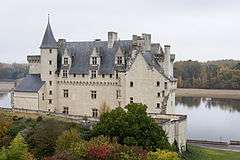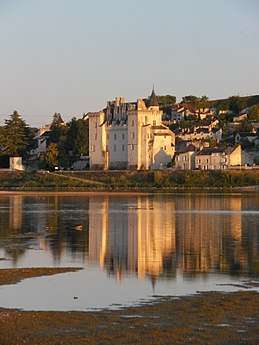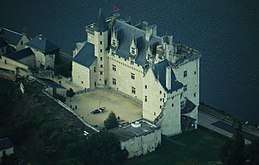Château de Montsoreau
| Château de Montsoreau | |
|---|---|
 | |
 Location of the Château de Montsoreau | |
| General information | |
| Architectural style | French Renaissance |
| Location | Montsoreau, France |
| Address | Château de Montsoreau, 49730 Montsoreau, France |
| Coordinates | 47°12′56″N 0°03′44″E / 47.2156°N 0.0622°ECoordinates: 47°12′56″N 0°03′44″E / 47.2156°N 0.0622°E |
| Current tenants | Philippe Méaille |
| Construction started | 1443 |
| Completed | 1515 |
| Height | 45m |
| Design and construction | |
| Architect | Unknown |
| Website | |
|
www | |
The Château de Montsoreau is a Renaissance style castle [1] in the Loire Valley,[2] directly built in the Loire[3] riverbed. It is located in the small market town of Montsoreau, in the Maine-et-Loire département of France, close to Saumur, Chinon, Fontevraud-L'abbaye and Candes-Saint-Martin. The Château de Montsoreau has an exceptional position at the confluence of two rivers, the Loire and the Vienne, and at the meeting point of three historic regions: Anjou, Poitou and Touraine. It is the only château of the Loire Valley to have been built directly on the Loire riverbed.
A Gallo-Roman origin has been verified for the settlement of Montsoreau but not confirmed for the castle, even though a fluted column made of stone from a Gallo-Roman temple or a public building[4] was found in the moat during the restoration works of the end of the 20th century. The first written sources are from the 6th century with the domain of Restis, but it is only with the construction of a fortress at the end of the 10th century that the market town began to become prosperous.[5] One part of this first castle was found during the same restoration works by the archaeologists.[6] The castle was reconstructed in a Renaissance style between 1450 and 1460 by Jean de Chambes, one of the kingdom's wealthiest men, a senior councillor and chamberlain to King Charles VII and to King Louis XI.
The Château de Montsoreau was immortalised by Alexandre Dumas in his novel La Dame de Monsoreau written between 1845 and 1846.[4] This novel is the second part of a trilogy on the Renaissance, between La Reine Margot and Les Quarante-cinq.
Unlike others châteaux of the Loire Valley, Montsoreau is the only one that is actually built on the Loire riverbed.
Parts of the Château de Montsoreau were listed as a monument historique by the French Ministry of Culture in 1862, 1930 and 1938.[7] The Loire Valley between Sully-sur-Loire and Chalonnes has been inscribed as a UNESCO World Heritage Site since 30 November 2000.[8]
In April 2016, the Château de Montsoreau became the Château de Montsoreau-Museum of Contemporary Art.[9]
History
Middle Ages
The first written source describing the site dates from the 6th century with the domaine de Restis.[10] It was transformed into a fortified castle by Eudes the First count of Blois in 990. In 1001, it was taken by the Anjou realm,[11] and Foulques Nerra gave it to Gautier I of Montsoreau. Gautier I belonged to one of the most pre-eminent families of Anjou.[12] Thus, the Castrum Monsorelli became one of the forty fortified castles in Anjou and one of the few to be given the title of lordship at the turn of 1000. A town developed quickly near the castle and in the narratio de commendatione Turonice provincie, edited by Salmon in 1854, the site was mentioned as one of oppidis munitissimi et populosis by the second half of 11th century.[13] A right to raise tax was attested in written sources from the 12th century.[14]
When the Fontevraud order was settled in 1101, Fontevraud Abbey was supervised by Gautier de Montsoreau, who took direct orders from the Count of Anjou.[15] Gautier's mother-in-law, Hersende de Champagne, was the first great prior and co-founder of the Abbey with Robert d'Arbrissel.
Guillaume IV de Montsoreau was on Geoffrey Plantagenet's side against his brother Henri II Plantagenet, the future King of England, and Eleanor of Aquitaine's husband. The latter besieged the castrum and took it at the end of August 1156, despite its fortification.[16] He captured Guillaume and his defenders. Guillaume IV, however, was restored to the castle later. An order of King Henry II of England (about 1068) concerning the landscape project of the Loire was signed by Guillaume de Montsoreau and his son Guillaume. In 1171, Guillaume’s son gave the Turpenay monks the right to build tax-free houses inside the castrum. Gauthier, his eldest son, had no sons and so the lordship passed to the Savary de Montbazon family, on the marriage of his daughter Ferrie in 1213[17] to Pierre II Savary de Montbazon, lord of Montbazon.
After his victory at Bouvines, Philippe-Auguste chose him in 1214, with Guy Turpin, archdeacon of Tours, to negotiate peace with King John. The second house of Montsoreau disappeared in 1362, with the wedding of the only daughter of Renaud VII and Guillaume II de Craon.[18] The fourth house, one of the Chabot family, lasted only a few decades.[19]
In 1450, in order to pay off various debts, Louis II Chabot sold his domains of Montsoreau and Coutancière to his brother-in-law Jean II de Chambes,[20] who undertook to rebuild the castle at Montsoreau.[21] A descendant of Angoumois old noble family (near the city of Angoulême), Jean II de Chambes began in Charles VII service as an esquire in 1426,[22] the years before the famous interview between the King and Jeanne d'Arc in the Castle of Chinon. Baker in chief, Councillor and Chambelain, he became in 1444 "first master of ostel" of the King[22]; at the same time he associated with Jacques Coeur.[23] Jean II de Chambes received a considerable amount of money that was owed to him.[24] He was trusted with several sensitive diplomatic missions and especially sent as ambassador to Venice in 1459 to prepare a new crusade.[25] His lordships of Montsoreau and Argenton, but also his governorship of La Rochelle and Lord Provost and Captain of Niort, Talmont-sur-Gironde and Aigues-Mortes assured him some substantial revenues.[26]
Modern times

From 1450 to 1460, Jean II de Chambes increasingly played a role as ambassador. He was called frequently out of Anjou, while the castle was being built. These ten years represent a remarkable rise of his political and financial influence including his closeness to Charles VII. Closer to Charles VII than Louis XI, Jean II de Chambes gradually withdrew from politics from 1461.[27]
Jean III de Chambes succeeded his father, who died in 1473 and married Marie de Chateaubriant, who founded in 1519 the Holy Cross Collegiate Church across[28] the moat surrounding the castle. In 1530, Philippe de Chambes, who lived in Montsoreau, married Anne de Laval-Montmorency. His eldest son, Jean VI de Chambes inherited the field of Coutancière and saw his lands made up into a barony in 1560.
Montsoreau was sacked by the Protestants in 1568. The Holy Cross Collegiate and the fortifications of the city were destroyed. Four years later, Jean VI de Chambes acquitted himself with zeal in the organisation of the "Saint Bartholomew Angevine[29]" in Saumur and Angers. His Barony was confirmed by Letters Patent in 1573 and 1575.[29]
After his death in 1575, his brother Charles de Chambes became Count of Montsoreau and the following year he married Françoise de Maridor, whose name remains attached to the murder of Louis de Bussy d'Amboise.[30]
Garnisons of fifty and twenty warriors lived in the castle in the course of the last decade of the 16th century.[31] This ceased to exist during the reign of Louis XIII, and René de Chambes sought a garrison of royal troops but was refused by Richelieu. As a counterfeiter, he was sentenced to death and had to flee to England and was never able to return. After the death of his successor Bernard de Chambes, the castle of Montsoreau was rarely occupied by its various owners. The eldest daughter of Bernard de Chambes married Louis Francis Bouchet, who died in 1716,[32] leaving 400,000 livres of debts. His eldest son Louis I de Bouchet, married Jeanne Pocholle Hamel[32] who brought a 200,000 livres dowry.
Contemporary period

The widow of Louis Francois II de Bouchet Sourches, Marquis of Tourzel, sold the château and what remained of the domain of Montsoreau after 1804. Following the sale of the property, the building was occupied by 19 different homeowners who reshaped the site. The external condition of the main building is known through various representations and descriptions made in the second half of the nineteenth century, which reflect the disrepair of the property.[33] In 1910, the château was in a pitiful state, and this moved the members of the French Archaeological Society (Société Française d'Archeologie). Thanks to the tenacity of Senator Geoffre who pleaded with the Maine et Loire department General Council, the situation evolved favorably. The department gradually acquired each property after 1913, Restoration works were undertaken in 1923 and continued without interruption until the Second World War.[34]
After a new programme of restoration between 1997 and 2001, the château opened to visitors on 6 July 2001 with a son-et-lumiere entitled "The Imaginaries of Loire" which attracted about 35,000 visitors a year.
In June 2015, the Maine and Loire council entrusted the keys of the Château de Montsoreau to the French collector of contemporary art, Philippe Méaille, to create a museum of contemporary art. Méaille opened the Château de Montsoreau-Museum of Contemporary Art to the public in April 2016. Its collection represents the world's largest holding of artworks by the Art & Language group of conceptual artists.[35] The Château de Montsoreau-Museum of Contemporary Art organises numerous events throughout the year: temporary exhibitions, conferences and symposia.
Geography : the site and its natural environment
Situation
The Château de Montsoreau is located in a strategic position, at the convergence of two rivers, the Loire and the Vienne, and also at the intersection of three historical political regions Anjou, Poitou and Touraine. It is situated in a nationally protected region, the Loire-Anjou-Touraine Regional Nature Park.
The castle was directly built into the bed of the Loire River, at the foot of the hillside, in tufa – the local bed-rock, still visible in many places. Many local properties are built from this stone and indeed there are many local houses built into the hillsides, and in the local caves. Its topographic position is said to be militarily undefendable, as it is located between two small valleys on a plateau of some thirty hectares with steep slopes to the east and the west.[36]
Architecture
Description
Jean II de Chambes built the Château de Montsoreau in 1455. The building marks the transition from military architecture to architecture for pleasure, as shown by the large windows, the numerous chimneys, and the attention paid to sanitation problems. The castle’s central dwelling was built directly on the banks of the Loire. The right-angled wing was built a few years later. Two square towers frame the main building. At a time when round towers were usually built, this odd choice prefigures the corner pavilions added later. A spiral staircase probably existed before the current Renaissance staircase.
The ground floor and courtyard side cellars permit control of navigation on the Loire. One of those rooms has direct access to the river. The main staircase on the left side leads to the ground floor dwelling and to the first floor salon. This very bright room, lit by five windows and with a length of seventeen metres, is heated by two monumental chimneys.
Small rooms surround the dwelling and show the transition between public and private areas. In 1473, Jean III de Chambes succeeded his father. He built a Renaissance staircase tower with a polygonal shaft topped by a terrace. The steps lead to an eight-wedged palmtree-shaped vault, quite similar to those found in Angers’ Barrault dwelling and Saumur’s town hall. The stairs are decorated by pilasters bordering the windows; medallions, putti and candelabra carried by lion’s paws.
A central panel shows a helmet bearing the family’s motto "Chambe Crie". The register above represents two monkeys holding the end of a chain. This chain is fixed around a loop belt under which is inscribed "Je le feray". At the other extreme of the chain, an ovoid object embellished by a leaf decoration is suspended through a hoop. A little monkey is crouching down the hoop’s left side. The upper panel is carved with trees and branches representing a coppice in front of which stand a deer, the chief symbol of the hunt.
The Château de Montsoreau in literature and cinema
Literature
The Château de Montsoreau was immortalised by Alexandre Dumas in La Dame de Monsoreau, a novel written between 1845 and 1846. This novel takes as a backdrop the Château de Montsoreau and is part of Alexandre Dumas' trilogy between La Reine Margot and Les Quarante-cinques.
La Dame de Monsoreau is an historic novel mixing two intrigues :
- A love story between Louis de Clermont, lordship of Bussy d'Amboise and Diane de Méridor, the Count of Montsoreau's wife.
- A politic intrigue setting politics and religious troubles under the King Henri III, including the rivalry with his brother, François de France, Duke of Alençon and then Duke of Anjou, a fascinating character without honour.
Cinema and audiovisual
- 1909 : La Dame de Monsoreau (La signora di Monsoreau, movie produced by Mario Caserini
- 1923 : La Dame de Monsoreau, French silent movie by René Le Somptier
- 1971 : La Dame de Monsoreau, TV broadcast by Yannick Andréi, with Nicolas Silberg (Bussy d'Amboise), Karin Petersen (Diane de Méridor), François Maistre (Count Brian de Montsoreau), Michel Cetron (Chicot) Gérard Berner (Duke of Anjou) and Denis Manuel (King Henri III).
- 2009 : La Dame de Monsoreau, TV broadcast made in 2006 by Michel Hassan, with Esther Nubiola (Diane de Méridor), Thomas Jouannet (Bussy d'Amboise), Anne Caillon (Dutchesse of Guise). Broadcast on TV on France 2 on 26 August 2009.
See also
References
- ↑ "Anjou-Département du Maine-et-Loire". culture.maine-et-loire.fr. 2001.
- ↑ "Page d'été : Découvrez Montsoreau". france3-regions.francetvinfo.fr. 2014.
- ↑ "Château de Montsoreau" (in French). parangone.fr. 28 May 2017.
- 1 2 "La Dame de Monsoreau" (in French). dumaspere.com. 1998.
- ↑ Litoux, Emmanuel (2003). Congrès Archéologique de France. Société Française d'Archéologie. p. 255.
- ↑ Prigent, Dominique (2003). Congrès Archéologique de France. Société Française d'Archéologie. p. 256.
- ↑ Ministry of Culture: Château (in French)
- ↑ "Val de Loire entre Sully-sur-Loire et Chalonnes" (in French). whc.unesco.org. 2000.
- ↑ Gleadell, Colin (23 June 2015). "Largest collection of radical conceptualists Art & Language finds a home in a French chateau". Artnet News.
- ↑ Prigent, Dominique (2003). Congrès Archéologique de France. Paris: Société Française d'Archéologie. p. 255.
- ↑ Guillot, Olivier (1972). Le comte d'Anjou et son entourage au XIe siècle. Paris. p. 310.
- ↑ Guillot, Olivier (1972). Le comte d'Anjou et son entourage au XIe siècle. Paris. p. 32.
- ↑ Boussard, Jean (1938). Le comté d'Anjou sous Henri Plantagenêt et ses fils. Paris. p. 11.
- ↑ Manase, Victor. "Montsoreau : un château, un port". Bull. Soc. des amis du pays Lochois. Loches: 87–99.
- ↑ Raimbault (1965). Notice historique sur le château et la commune de Montsoreau. Angers: Arch. Départementales du Maine-et-Loire. pp. 304–314.
- ↑ Desme de Chavigny, Olivier (1888). Les anciens seigneurs de Montsoreau. Tours. p. 18.
- ↑ Derigal, Daniel (2017). "Pierre II de Montbazon". daniel.derigal.free.fr.
- ↑ Bianco, Thierry and Hélène (2000). "Les sires de Montsoreau". thierryhelene.bianco.free.fr.
- ↑ de Sainte-Marie, Anselme (1728). Histoire de la maison royale de France. Paris: La compagnie des libraires. p. 563.
- ↑ Jean II de Chambes épouse Jeanne Chabot, première dame d'honneur de la reine, le 17 mars 1445
- ↑ UNESCO (22 May 2017). "Charles VII et Louis XI". valdeloire.org.
- 1 2 Bachelier (2000). "Chambes". bachelier.free.fr.
- ↑ Mollat, M. (1952). Les affaires de Jacques Coeur, journal du procureur Dauvet. Paris. pp. 483, 618.
- ↑ "Jean II de Chambes" (PDF). geneanet. 2001.
- ↑ du Romant d'Amat, Prévost (1959). Dictionnaire de biographie française. Paris. p. 243.
- ↑ Bachelier (12 February 2005). "De Chambes". bachelier.free.fr.
- ↑ Prigent, Dominique (2003). Congrès Archéologique de France. Paris: Société d'Archéologie Française. p. 256.
- ↑ Litoux, Emmanuel (2003). Congrès Archéologique de France. Paris: Société Française d'Archéologie. p. 256.
- 1 2 Bianco, Thierry et Hélène (2000). "Les sires de Montsoreau". thierryhelene.bianco.free.fr.
- ↑ Levron, J. (1938). La véritable histoire de la dame de Montsoreau. Paris: Chapelon.
- ↑ Seignan, M. (1922). La garnison du château de Montsoreau. Saumur: Bull. Soc. Lettres, Sci. et Arts du Saumurois. pp. 15–19.
- 1 2 L'abbé Expilly (1770). Dictionnaire Géographique, Historique et Politique des Gaules et de la France. Paris: Edition scientifiques Royales. p. 867.
- ↑ Significant views of the château before restoration : A.D. Maine-et-Loire, Coll. Icon. Célestin Port, Carton 27
- ↑ "Le château de Montsoreau". Conseil départemental du Maine-et-Loire. 2016.
- ↑ de Montjoie, Daisy (25 June 2016). "Philippe Méaille installe sa collection au Château de Montsoreau". Connaissance des Arts.
- Gleadell, Colin (23 June 2015). "Largest Collection of Radical Conceptualists Art & Language Finds a Home in a French Château". Artnet News. - ↑ Litoux, Emmanuel (2003). Congrès Archéologique de France. Paris: Société Française d'Archéologie. p. 257.
External links
| Wikimedia Commons has media related to Château de Montsoreau. |
- Official website
- Ministry of Culture listing for Château de Montsoreau (in French)
- Ministry of Culture photos
